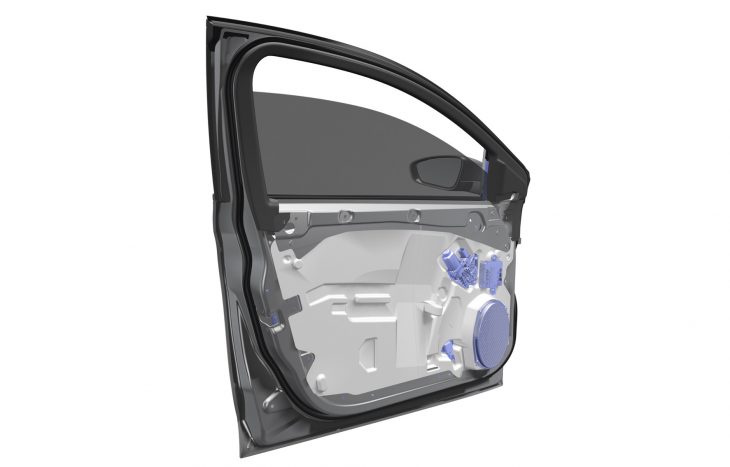Magna International Inc. — in cooperation with the U.S. Department of Energy (DOE) and partners Fiat Chrysler Automotive (FCA) US and Grupo Antolin — developed a new, ultralight door architecture that achieves 42.5% mass savings compared to an average current production door. The door-in-white assembly makes extensive use of aluminum, which achieves approximately half of the total mass reduction of the door assembly. Overall, the project makes use of materials readily available today that can easily be made using existing manufacturing processes, without a significant increase in production costs or changes in body-shop infrastructure.
A key innovation associated with the development of the ultralight door includes integration of Magna’s SmartLatch™ electronic latch system. This eliminated the need for mechanical hardware and enabled the development of a unique carrier module with integrated glass guides and lift capability of a lightweight hybrid glass laminate, an industry first.
For this advanced ultralight door project, Magna built on its know-how from the development of the Multi-Material Lightweight Vehicle (MMLV) with the DOE and Ford in 2014. Magna’s advanced engineering team – a collaborative effort between the company’s corporate R&D and various product groups – combined its unique, full-vehicle perspective on the design of a driver’s-side door with an inventive mix of materials and technology to tackle the challenge of significant weight reduction. This was developed in less than 10 months while keeping the cost within accepted industry parameters and providing a solution that applies to approximately 70 percent of the light vehicle market.
“The team started from scratch and reimagined the way we think about the design, development, and material-use of a door architecture,” said Swamy Kotagiri, chief technology officer, Magna International. “Building on our significant expertise in lightweighting from previous DOE projects, the team leveraged our broad product-development expertise and tackled this challenge in a cost-effective manner while meeting safety, durability and functionality requirements.”
Grupo Antolin contributed to the project in the design and manufacture of interior trim components in order to provide significant mass reduction. The application of advanced molding technologies and polymers contributed approximately 7% to the total mass reduction.
The ultralight door development included intensive simulation efforts, passing all safety and durability testing in the process. The next steps include manufacturing full-scale prototype door assemblies, performance tests and safety tests to validate the design, with the goal of being available for use in production vehicles by the fall of 2020.
The FCA US engineering team was an integral part of the design and development of the ultralight door, providing engineering collaboration to confirm compatibility with existing assembly operations, as well as CAE durability, fatigue, and safety analysis. FCA US plans to conduct testing of prototype door assemblies and full vehicles to validate the results of the predictive simulation.
Note: This material is based upon work supported by the DOE, Office of Energy Efficiency and Renewable Energy (EERE), under award number DE-0007306.

